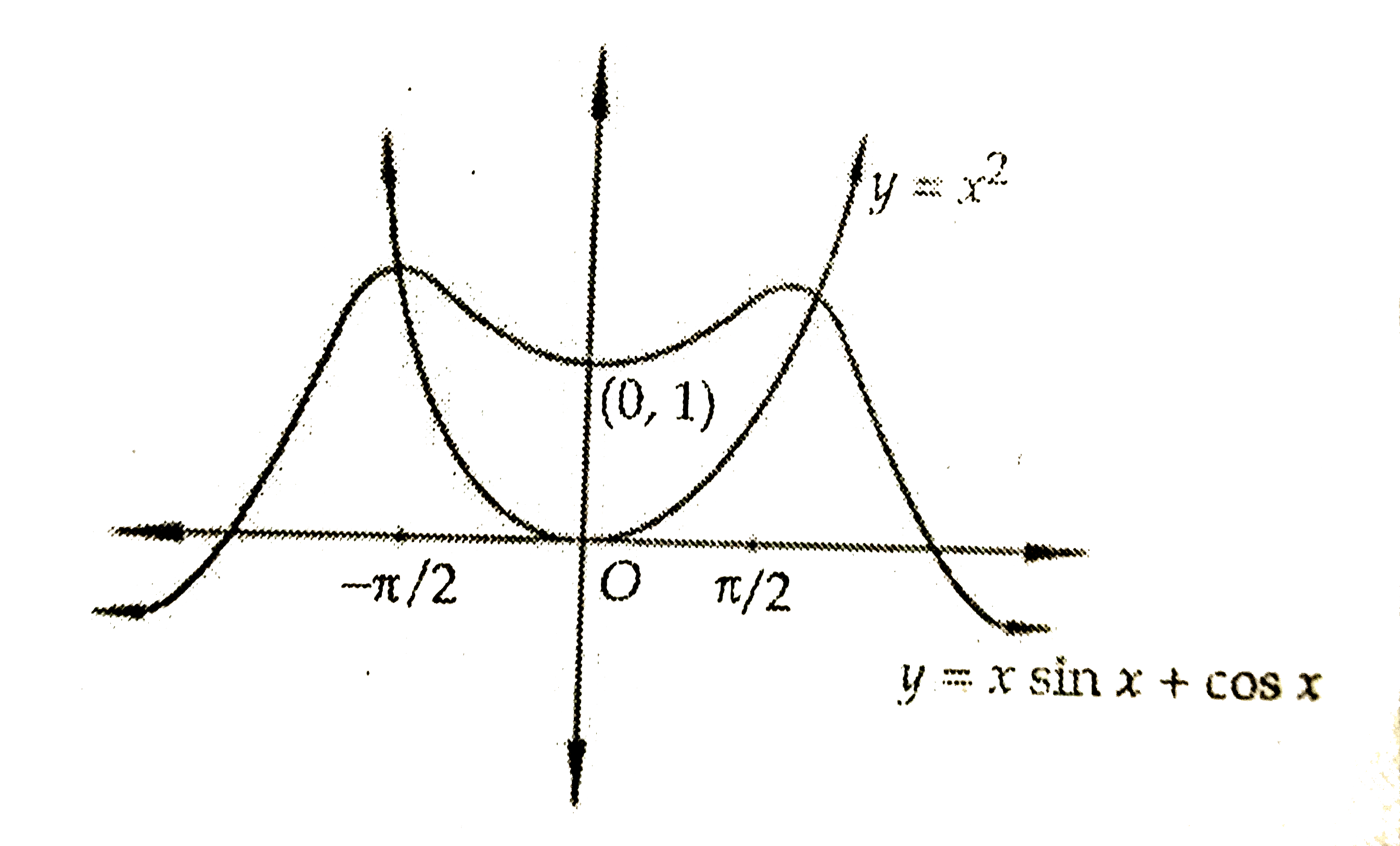The number of points in (−∞,∞), for which x2−xsinx−cosx=0, is
6
4
2
0
The correct Answer is:C
We have to find the number of solution of the equation
x2−xsinx−cosx=0 or ,x2=xsinx+cosx
Let f(x)=x2 and g(x)=xsinx+cosx
Clearly, the numbers of solutions of the curves y=f(x) and y=g(x). The curve y=f(x) is a parabola with vertex at (0,0) and y-axis as axis of symmetry.
Now,g(x)=xsinx+cosx
⇒g'(x)=xcosx
The changes in signs of g'(x) are shown in the Figure 16.

Clearly, x=0,3π2 are points of relative minima and x=±π2,x=5π2 etc are points of relative maxima. Also, g(x)=xsinx+cosx is an even function and g(0)=1, g(π/2)=π/2 and g(π)=−1. So, a rough sketch of y=g(x) is as shown in Figure 17.
Clearly, y=f(x) and y=g(x) intersect at two points.
Hence, given equation has two solutions.

Topper's Solved these Questions
- MISCELLANEOUS EQUATIONS AND INEQUATIONS BOOK - OBJECTIVE RD SHARMA ENGLISHCHAPTER - MISCELLANEOUS EQUATIONS AND INEQUATIONS EXERCISE - Exercise
30 Videos
- MISCELLANEOUS EQUATIONS AND INEQUATIONS BOOK - OBJECTIVE RD SHARMA ENGLISHCHAPTER - MISCELLANEOUS EQUATIONS AND INEQUATIONS EXERCISE - Chapter Test
29 Videos
- MEASURES OF CENTRAL TENDENCYBOOK - OBJECTIVE RD SHARMA ENGLISHCHAPTER - MEASURES OF CENTRAL TENDENCYEXERCISE - Chapter Test
21 Videos
- PLANE AND STRAIGHT LINE IN SPACE BOOK - OBJECTIVE RD SHARMA ENGLISHCHAPTER - PLANE AND STRAIGHT LINE IN SPACE EXERCISE - Chapter Test
31 Videos
Similar Questions
Knowledge Check
The solution of system of linear inequalities in x represented on line as

(i) x∈(−∞,−4)∪[3,∞)
(ii) x∈(−∞,−4]∪(5,∞)
(iii) x∈(−∞,−3)∪(5,∞)
(iv) x∈(−∞,−4)∪[5,∞)Ax∈(−∞,−4)∪[3,∞)Bx∈(−∞,−4]∪(5,∞)Cx∈(−∞,−3)∪(5,∞)Dx∈(−∞,−4)∪[5,∞)
The range of k for which the inequality kcos2x−kcosx+1≥0∀xε(−∞,∞) is:
View SolutionTh range of k for which the inequaliity kcos2x−kcosx+1≥0∀x∈(−∞,∞)is
View SolutionTh range of k for which the inequaliity kcos2x−kcosx+1≥0∀x∈(−∞,∞)is
View SolutionLet A(0,2),B and C be points on parabola y2+x+4 such that ∠CBAπ2. Then the range of ordinate of C is (a) (−∞,0)∪(4,∞) (b) (−∞,0]∪[4,∞) (c) [0,4] (d) (−∞,0)∪[4,∞)
View SolutionLet f(x)<0∀x∈(−∞,0)andf(x)>0∀x∈(0,∞) also f(0)=0, Again f'(x)<0∀x∈(−∞,−1)andf'(x)>0∀x∈(−1,∞) also f'(−1)=0 given limx→−∞f(x)=0andlimx→∞f(x)=∞ and function is twice differentiable.
The minimum number of points where f'(x) is zero is: (a) 1 (b) 2 (c) 3 (d) 4
View SolutionThe range of a for which the equation x2+ax−4=0 has its smaller root in the interval (−1,2)is a. (−∞,−3) b. (0,3) c. (0,∞) d. (−∞,−3)∪(0,∞)
View SolutionLet f be the function f(x)=cosx−(1−x22). Then (a) f(x) is an increasing function in (0,∞) (b) f(x) is a decreasing function in (−∞,∞) (c) f(x) is an increasing function in (−∞,∞) (d) f(x) is a decreasing function in (−∞,0)
View Solution
